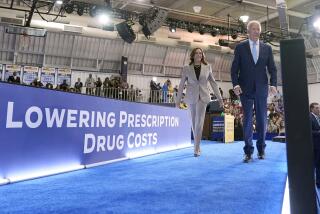Cost of Medicare’s Part D drug plan is dropping
- Share via
Reporting from Washington — Even as health costs continue to rise, Medicare beneficiaries will see the average price of a Part D drug plan decline slightly next year, the Obama administration announced Thursday, offering some relief amid pressure to cut the federal health insurance program for the elderly.
The Part D drug benefit, created under the George W. Bush administration, allows seniors and others on Medicare to sign up for a privately administered, government-subsidized health plan to get their prescriptions.
Popular with beneficiaries, the program has also proven far less costly than budget analysts originally expected, in part because of competition among private plans and the growing use of less expensive generic drugs.
In 2012, the average Part D plan will charge seniors about $30 a month, the Department of Health and Human Services said.
That’s down from $30.76 in 2011 and would mark the second time average premiums have declined since the drug benefit was initiated in 2006.
By comparison, overall healthcare spending in the U.S. is expected to grow by nearly 5% a year between now and 2014, according to the latest estimates by government actuaries. Premiums on many private medical insurance policies are rising even more sharply.
The Obama administration has been working to strengthen the Medicare drug benefit with the help of the healthcare law the president signed last year. The law gradually phases out the coverage gap known as the doughnut hole, long viewed as a weakness in the program.
Last year, about 4 million seniors received $250 rebate checks when they fell into the gap in coverage, thanks to the law. This year, the law will provide 50% discounts on prescriptions for those who hit the doughnut hole.
Administration officials also announced Thursday that more than 17 million Medicare beneficiaries had taken advantage of preventive services such as cancer screenings that are now available without co-payments, another benefit of the law.
And more than 1 million people have seen a physician for Medicare’s annual wellness visit, which the law also makes available without a co-pay.
Though celebrated by the Obama administration, the widely acknowledged success of the Part D program is also fueling calls from conservatives to expand privatization of the Medicare program.
Many House Republicans pointed to the drug program in pushing their plan to replace Medicare with a system of vouchers that seniors would use to purchase private health coverage.
Dr. Don Berwick, who oversees the Medicare and Medicaid program, cautioned Thursday that the broader privatization championed by House Budget Committee Chairman Paul D. Ryan (R-Wis.) would actually mean higher costs for seniors.
“The Ryan plan is very Draconian from the point of view of the beneficiaries,” Berwick said. “We’re able to offer the benefits of this kind of choice and competitive force under the current Medicare program.”
An independent analysis of the House Republican proposal by the nonpartisan Congressional Budget Office estimated that the voucher system would force seniors on average to pay $6,000 more per year out of their own pocket for medical care.
Pharmaceutical and insurance industry leaders, meanwhile, cheered the lower Part D premiums.
“These facts illustrate that Medicare Part D is a model for healthcare that should be emulated, not be weakened by unsound policy proposals,” said Karl Uhlendorf, a vice president at Pharmaceutical Research and Manufacturers of America.
The influential trade group is fighting proposals to force drug makers to provide bigger discounts for low-income seniors who are insured by the Medicare and Medicaid programs, one of several proposals that have been considered to further control federal health spending.
More to Read
Get the L.A. Times Politics newsletter
Deeply reported insights into legislation, politics and policy from Sacramento, Washington and beyond. In your inbox twice per week.
You may occasionally receive promotional content from the Los Angeles Times.











